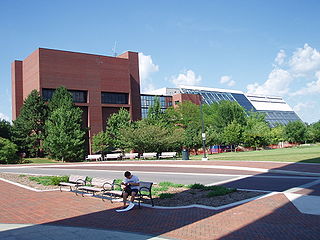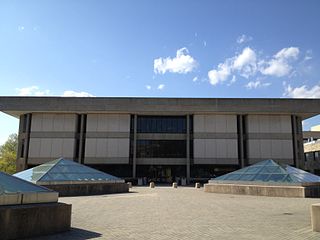
Pratt Institute is a private university with its main campus in Brooklyn, New York. It has a satellite campus in Manhattan and an extension campus in Utica, New York at the Munson-Williams-Proctor Arts Institute. The school was founded in 1887 with programs primarily in engineering, architecture, and fine arts. Comprising six schools, the institute is primarily known for its programs in architecture, graphic design, interior design, and industrial design.

Newbury Street is located in the Back Bay area of Boston, Massachusetts, in the United States. It runs roughly east–west, from the Boston Public Garden to Brookline Avenue. The road crosses many major arteries along its path, with an entrance to the Massachusetts Turnpike westbound at Massachusetts Avenue. Newbury Street is a destination known for its many retail shops and restaurants.

Guy Lowell, was an American architect and landscape architect.
Will Bruder is an American architect.

1 Spadina Crescent, also known as the Daniels Building, is an academic building that houses the John H. Daniels Faculty of Architecture, Landscape, and Design at the University of Toronto in Toronto, Ontario, Canada. The building is situated in the centre of a roundabout of Spadina Avenue, north of College Street. Its location provides a picturesque vista looking north up Spadina Avenue; it is an axial view terminus for Spadina Avenue.

The University of Illinois School of Architecture is an academic unit within the College of Fine & Applied Arts at the University of Illinois Urbana-Champaign. The school is organized around four Program Areas - Building Performance, Detail + Fabrication, Health + Well-being, and Urbanism. Faculty teach and conduct research in these areas in support of the School's primary objective to promote critical engagement with the design of a healthy and sustainable built environment.

The FIU School of Architecture is the architecture school at Florida International University, located in Miami, Florida in the United States. It is one of the university's 26 schools and colleges and is a school within the College of Architecture and the Arts. The school was founded in the 1980s.

The School of Architecture (SOA) is part of the College of Fine Arts at University of Nevada, Las Vegas. It is accredited by the National Architectural Accrediting Board (NAAB) in October 1997 and currently provides the only program accredited for architecture in the state of Nevada. The school offers a Bachelor of Science in architecture, interior architecture and landscape architecture. It also offers a master of architecture as a professional degree and a master of healthcare interior design.

The building at 941–955 Boylston Street in the Back Bay district of Boston, Massachusetts was designed by Arthur H. Vinal in 1886, while he was City Architect, as the city's first combined fire and police station. The building, constructed in 1887, is in the Richardsonian Romanesque style, as was Vinal's most notable other work, the Chestnut Hill Water Works pumping station, built at about the same time. It has been designated a Boston Landmark by the Boston Landmarks Commission.

The University of Texas at Austin School of Architecture (UTSOA) is a college within The University of Texas at Austin, with its major facilities located on the main university campus in Austin, Texas, United States.

The MIT School of Architecture and Planning is one of the five schools of the Massachusetts Institute of Technology in Cambridge, Massachusetts. Founded in 1865 by William Robert Ware, the school offered the first architecture curriculum in the United States and was the first architecture program established within a university. MIT's Department of Architecture has consistently ranked among the top architecture/built environment schools in the world.

The University of Oregon College of Design is a public college of architecture and visual arts in the U.S. state of Oregon. Founded in 1914 by Ellis F. Lawrence, the college is located on the University of Oregon campus in Eugene, off the corner of 13th and University streets, and also has programs at the historic White Stag Block in Portland, Oregon.

The R. Wayne Estopinal College of Architecture and Planning, commonly referred to as CAP, is one of seven academic colleges of Ball State University based in Muncie, Indiana, with a satellite facility in Indianapolis. The college offers degrees in architecture, landscape architecture, urban planning, historic preservation, urban design, construction management, and interior design. CAP was established in 1965.

The Fay Jones School of Architecture and Design, founded in 1946 by John G. Williams at the University of Arkansas, offers education in these fields: architecture, landscape architecture and interior design.
The USC School of Architecture is the architecture school at the University of Southern California. Located in Los Angeles, California, it is one of the university's twenty-two professional schools, offering both undergraduate and graduate degrees in the fields of architecture, building science, landscape architecture and heritage conservation.
Arcangelo "Angelo" Cascieri was an influential sculptor and a major figure in the evolution of the Boston Architectural College in Boston, Massachusetts.
The New England School of Art and Design at Suffolk University is a school of fine arts and design located in Boston, Massachusetts. The school offers undergraduate (BFA) and graduate (MA) degrees, as well as continuing education courses and programs. The School of Art & Design is accredited by the National Association of Schools of Art and Design (NASAD). The BFA program in Interior Design and MA program in Interior Architecture & Design are accredited by the Council for Interior Design Accreditation (CIDA). Suffolk University is accredited by the New England Association of Schools and Colleges.

The College of Architecture, Arts, and Design formerly the College of Architecture and Urban Studies at Virginia Tech consists of four schools, including the School of Architecture, which consistently ranks among the best in the country. Headquartered in Blacksburg, Virginia, the college also has sites in Alexandria, Virginia, and Riva San Vitale, Switzerland. Spread out among these three locations, the college consists of nearly 2,200 students, making it one of the largest schools of architecture in the nation.
Christof Jantzen is an architect based in Los Angeles, California. Throughout his professional career Jantzen has directed and designed various sustainably designed projects. Many have received international recognition for leadership in global green design including the Santa Monica Parking Structure #6, the Genzyme Corporate Headquarters, Mill Street Lofts, Los Angeles and the Harvard Allston Science Complex. Other recognition of Jantzens's work includes the Leadership in Energy and Environmental Design (LEED) Platinum Award, AIA/COTE Top Ten Green Project Award, California Green Leadership Award, Northeast Sustainable Energy Association Award, American Architecture Award... Jantzen was the founding partner of Behnisch Architekten LLP in the United States. He is a professor at Washington University in St. Louis Center for the Environment. Jantzen taught design at the Southern California Institute of Architecture, California State Polytechnic University and the University of Southern California. He is the principal and owner of the Venice, California -based architectural practice Studio Jantzen.

320 Newbury Street is a six-story academic building on Newbury Street in the Back Bay neighborhood of Boston, Massachusetts. Since its opening in 1966, it has been the main facility for the Boston Architectural College. It was designed in the Brutalist style by Ashley, Myer & Associates.

















